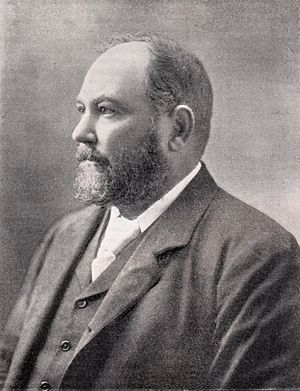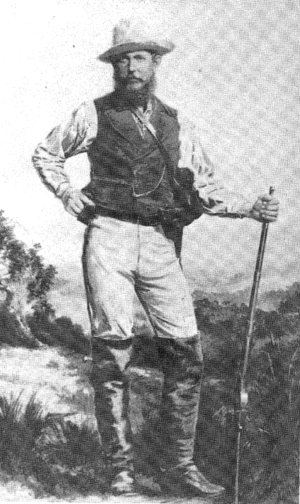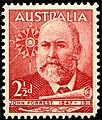John Forrest facts for kids
Quick facts for kids
The Lord Forrest of Bunbury
|
|
|---|---|
 |
|
| 1st Premier of Western Australia | |
| In office 22 December 1890 – 15 February 1901 |
|
| Succeeded by | George Throssell |
| Constituency | Bunbury |
| Personal details | |
| Born | 22 August 1847 Bunbury, Western Australia |
| Died | 2 September 1918 (aged 71) at sea off the coast of Sierra Leone |
| Resting place | Karrakatta Cemetery |
| Political party | Independent (1890–1901), Protectionist (1901–1906), WA Party (1906–1909), Liberal (1909–1917), Nationalist (1917–1918) |
| Spouse | Margaret Elvire Hamersley |
| Signature | |
John Forrest, 1st Baron Forrest of Bunbury GCMG (22 August 1847 – 2 September 1918) was an Australian explorer, the first Premier of Western Australia and a cabinet minister in Australia's first federal parliament.
As a young man, he won fame as an explorer by leading three expeditions into the interior of Western Australia, for which he was awarded the 1876 Royal Geographical Society's Patron's Medal.
He was appointed Surveyor General and in 1890 became the first Premier of Western Australia, its only premier as a self-governing colony. Forrest's premiership gave the state ten years of stable administration during a period of rapid development and demographic change. He pursued a policy of large-scale public works and extensive land settlement, and he helped to ensure that Western Australia joined the federation of Australian states.
After federation, he moved to federal politics, where he was at various times postmaster-general, Minister for Defence, Minister for Home Affairs, Treasurer and acting Prime Minister. He was affiliated with the Protectionist Party, the Western Australian Party, the Commonwealth Liberal Party, then the [[Nationalist Party of Australia].
Shortly before his death, Forrest was informed that the King had approved his elevation to the British peerage as Baron Forrest of Bunbury.
Contents
Early years
Forrest was born on 22 August 1847 on his father's property 2 miles (3.2 km) outside of Bunbury, Western Australia. He was the fourth of ten children and third of nine sons born to Margaret (née Hill) and William Forrest.
Forrest's parents had arrived from Scotland in December 1842, accompanying Dr John Ferguson to work as domestic servants on his farm in the newly settled district of Australind. Margaret was from Dundee and William from Kincardineshire; the Forrest paternal line originated from the village of Glenbervie. They were released from Ferguson's service in 1846, and William took up a property at the mouth of the Preston River on the eastern side of the Leschenault Estuary. He built a windmill and a small house, where John was born.
A few years after Forrest's birth, the family moved down the Preston River to Picton, where William built a homestead and watermill. The mill was primarily used as a flour mill, at a time when flour was a scarce commodity, but was also used as a sawmill. Its success allowed William to expand his land holdings to 400 acres (160 ha) and gave the family a high social status in the small district around Bunbury. The property remains in the ownership of his descendants and is now heritage-listed.
Forrest and his brothers began their education at the one-room school in Bunbury, walking or riding 4 miles (6.4 km) in each direction. His parents prized education, and in 1860 he was sent to Perth to board at Bishop Hale's School, the only secondary school in the colony. He attended the school for four years, winning several prizes for arithmetic. Although three of William Forrest's sons became members of parliament, he had no involvement in public life beyond a local level and was not known to hold strong political opinions. According to John Forrest's biographer Frank Crowley, "William Forrest's greatest gift to his sons was not a precise political creed but the practical approach to life that he had acquired as a tradesman, farmer and jack-of-all-trades".
Career
In November 1863, Forrest was apprenticed to a government land surveyor named Thomas Carey. When his term of apprenticeship ended in November 1865, he became the first man born and educated in the colony to qualify as a land surveyor. He then commenced work as a surveyor with the government's Lands and Surveys Department.
Forrest came to public notice in 1869 when he led an expedition into the interior in search of Ludwig Leichhardt. The following year, Forrest accomplished the first land crossing from Perth to Adelaide across the Nullarbor Plain. His third expedition in 1874 travelled from Geraldton to Adelaide through the centre of Australia. Forrest's expeditions were characterised by a cautious, well-planned approach and diligent record-keeping. He received the Patron's Medal of the Royal Geographical Society in 1876.
Forrest became involved in politics through his promotion to surveyor-general, a powerful position that entitled him to a seat on the colony's executive council. He was appointed as Western Australia's first premier in 1890, following the granting of responsible government. The gold rushes of the early 1890s saw a large increase in the colony's population and allowed for a program of public works, including the construction of Fremantle Harbour and the Goldfields Water Supply Scheme. Forrest's government also passed a number of social reforms, maintaining power through several elections in an era before formal political parties. His support for Federation was crucial in Western Australia's decision to join as an original member.
In 1901, Forrest was invited to join Prime Minister Edmund Barton's inaugural federal cabinet. He was a member of all but one non-Labor government over the following two decades, serving as Postmaster-General (1901), Minister for Defence (1901–1903), Minister for Home Affairs (1903–1904), and Treasurer (1905–1907, 1909–1910, 1913–1914, 1917–1918). He helped shape Australia's early defence and financial policies, also lobbying for the construction of the Trans-Australian Railway, a pet project. Forrest served briefly as acting prime minister in 1907 and in 1913 was defeated for the leadership of the Liberal Party by a single vote. He was nominated to the peerage in 1918 by Prime Minister Billy Hughes, but died before the appointment could be confirmed.
Death
Forrest had been suffering from a cancer on his temple since early in 1917, and by 1918, he was very ill. He resigned as treasurer on 21 March 1918, and shortly afterwards boarded ship for London, where he hoped to obtain specialist medical attention. He also hoped to be able to take his seat in the House of Lords. However, on 2 September 1918, with his ship off the coast of Sierra Leone, he died. He was buried there, but his remains were later brought back to Western Australia and interred in Karrakatta Cemetery.
Personal life
On 2 September 1876 in Perth, Forrest married Margaret Elvire Hamersley. The Hamersleys were a very wealthy family, and Forrest gained substantially in wealth and social standing from the marriage. However, to their disappointment they had no children.
Legacy
Forrest's legacy can be found in the Western Australian landscape, with many places named by or after him:
- the small settlement of Forrest on the Trans-Australian Railway;
- Glen Forrest;
- Forrestdale;
- John Forrest National Park;
- Forrest River;
- Forrest Chase;
- Forrestfield and
- John Forrest Secondary College in Morley.
In addition, the electoral Division of Forrest was created in 1922; the suburb of Forrest, Australian Capital Territory is named after Forrest, as one of the many suburbs of Canberra named after Australia's first federal politicians.
The Forrest Highway, opened in September 2009, was named after him. The Eyre Highway was first known as the Forrest Highway, when it was first established as an unsealed road in 1942.
He is one of many railroad builders featured as a possible computer-controlled competitor in the simulation game Railroad Tycoon 3.
On 28 November 1949, the Australian post office issued a commemorative stamp that featured Forrest.
The Lord Forrest Hotel opened in Bunbury in 1986 even though he was never correctly known by that name. It is still running today and proudly displays his pictures on the walls. It is the largest hotel in Bunbury.
Images for kids
-
A bookplate of Forrest











